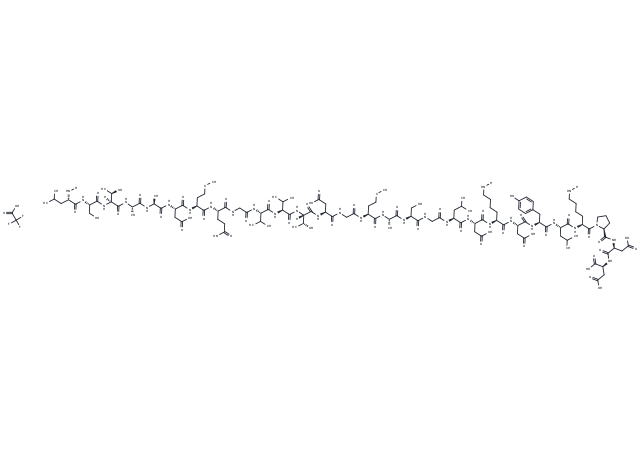 Your shopping cart is currently empty
Your shopping cart is currently empty

Azurin (50-77) is a peptide fragment derived from the copper-containing bacterial protein azurin, present in P. aeruginosa. It exhibits properties that regulate the cell cycle, inhibit cancer proliferation, and manage angiogenesis, proving its potential as an anticancer agent. Specifically, this compound acts as a VEGFR2 inhibitor with an IC20 of approximately 10.7 µM. At a concentration of 20 µM, it effectively induces cell cycle arrest at the G2/M phase in MCF-7 breast cancer cells, while a higher concentration of 50 µM significantly reduces the proliferation of both MCF-7 and ZR-75-1 breast cancer cell lines. Furthermore, Azurin (50-77) impedes VEGF-A-induced capillary tube formation with an IC50 of 12 µM, and alters the cellular and extracellular levels of critical signaling and structural proteins such as F-actin, focal adhesion kinase (FAK), paxillin, and platelet endothelial cell adhesion molecule-1 (PECAM-1) in human umbilical vein endothelial cells (HUVECs) at a concentration of 25 µM. Demonstrating its efficacy in vivo, Azurin (50-77) administered at 10 mg/kg per day notably reduces tumor volume in an MCF-7 mouse xenograft model, highlighting its therapeutic potential.

| Pack Size | Price | USA Warehouse | Global Warehouse | Quantity |
|---|---|---|---|---|
| 1 mg | $63 | Inquiry | Inquiry | |
| 5 mg | $296 | Inquiry | Inquiry | |
| 10 mg | $561 | Inquiry | Inquiry |
| Description | Azurin (50-77) is a peptide fragment derived from the copper-containing bacterial protein azurin, present in P. aeruginosa. It exhibits properties that regulate the cell cycle, inhibit cancer proliferation, and manage angiogenesis, proving its potential as an anticancer agent. Specifically, this compound acts as a VEGFR2 inhibitor with an IC20 of approximately 10.7 µM. At a concentration of 20 µM, it effectively induces cell cycle arrest at the G2/M phase in MCF-7 breast cancer cells, while a higher concentration of 50 µM significantly reduces the proliferation of both MCF-7 and ZR-75-1 breast cancer cell lines. Furthermore, Azurin (50-77) impedes VEGF-A-induced capillary tube formation with an IC50 of 12 µM, and alters the cellular and extracellular levels of critical signaling and structural proteins such as F-actin, focal adhesion kinase (FAK), paxillin, and platelet endothelial cell adhesion molecule-1 (PECAM-1) in human umbilical vein endothelial cells (HUVECs) at a concentration of 25 µM. Demonstrating its efficacy in vivo, Azurin (50-77) administered at 10 mg/kg per day notably reduces tumor volume in an MCF-7 mouse xenograft model, highlighting its therapeutic potential. |
| Synonyms | p28, Azurin p28 |
| Molecular Weight | 2914.18 |
| Formula | C122H197N31O47S2.XCF3COOH |
| Smiles | OC(C(F)(F)F)=O.CC(C)C[C@@H](C(N[C@@H](CO)C(N[C@]([C@H](O)C)([H])C(N[C@H](C(N[C@H](C(N[C@@H](CC(O)=O)C(N[C@@H](CCSC)C(N[C@@H](CCC(N)=O)C(NCC(N[C@@H](C(C)C)C(N[C@@H](C(C)C)C(N[C@]([C@H](O)C)([H])C(N[C@@H](CC(O)=O)C(NCC(N[C@@H](CCSC)C(N[C@H](C(N[C@@H](CO)C(NCC(N[C@H](C(N[C@@H](CC(O)=O)C(N[C@@H](CCCCN[H])C(N[C@@H](CC(O)=O)C(N[C@@H](CC1=CC=C(O)C=C1)C(N[C@H](C(N[C@@H](CCCCN[H])C(N2CCC[C@H]2C(N[C@@H](CC(O)=O)C(N[C@@H](CC(O)=O)C(O)=O)=O)=O)=O)=O)CC(C)C)=O)=O)=O)=O)=O)CC(C)C)=O)=O)=O)C)=O)=O)=O)=O)=O)=O)=O)=O)=O)=O)=O)C)=O)C)=O)=O)=O)N[H] |
| Storage | keep away from moisture | Powder: -20°C for 3 years | In solvent: -80°C for 1 year | Shipping with blue ice/Shipping at ambient temperature. | ||||||||||
| Solubility Information | DMSO: 30 mg/mL (10.29 mM), Sonication is recommended. Ethanol: 5 mg/mL (1.72 mM), Sonication is recommended. DMF: 5 mg/mL (1.72 mM), Sonication is recommended. PBS pH 7.2: 10 mg/mL (3.43 mM), Sonication is recommended. | ||||||||||
Solution Preparation Table | |||||||||||
Ethanol/DMF/PBS pH 7.2/DMSO
| |||||||||||
| Size | Quantity | Unit Price | Amount | Operation |
|---|

Copyright © 2015-2026 TargetMol Chemicals Inc. All Rights Reserved.